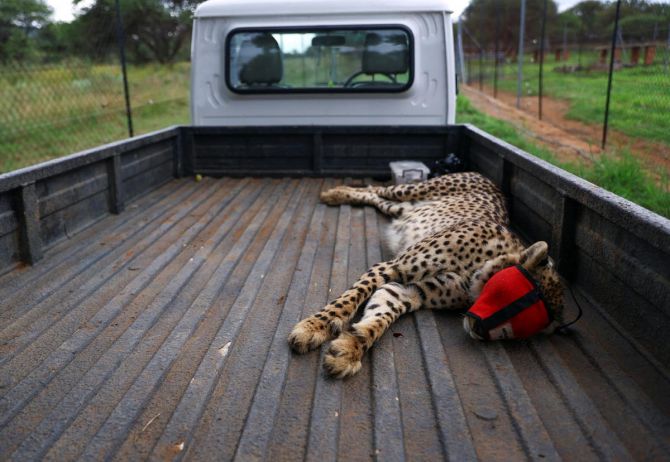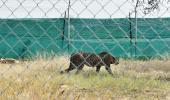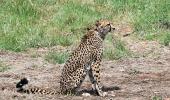South African wildlife expert Vincent van der Merwe on Thursday recommended fencing the cheetah habitats to circumscribe the overall threat to the big cats recently introduced in the country, prevent their 'extreme ranging behaviour', and protect the prey base from anthropogenic pressures such as poaching.

In an interview with PTI, Van der Merwe said the reintroduction project is going to see even higher mortality in the next few months when cheetahs try to establish territories and come face to face with leopards and tigers at the Kuno National Park.
He was sadly on the mark with his prediction as the sanctuary in Madhya Pradesh lost two more cheetah cubs on Thursday, marring further the government's much vaunted project to repopulate cheetahs in the country.
"Very unfortunate, but not unusual for first-time mothers to lose their first litter," he said.
Van der Merwe, who is closely involved with the project, said though the cheetah deaths have been within the acceptable range, the team of experts that reviewed the project recently did not expect males to kill a South African female cheetah during courtship and 'they take full responsibility for this'.
"There has never been a successful reintroduction (of cheetahs) into an unfenced reserve in recorded history. It has been attempted 15 times in Africa and it failed every time. We are not advocating that India must fence all of its cheetah reserves, we are saying that just fence two or three and create source reserves to top up sink reserves," Van der Merwe told PTI.
Fencing is done to mitigate human-wildlife conflict and pressures of predation or poaching on endangered species.
Source reserves are habitats that provide optimal conditions for the population growth and reproduction of a particular species.
These areas have abundant resources, suitable habitats, and favourable environmental conditions. They can support self-sustaining populations that produce a surplus of individuals, which can then disperse to other areas.
Sink reserves, on the other hand, are habitats that have limited resources or environmental conditions that are less favourable for the survival or reproduction of a species.
Sink reserves are reliant on dispersing individuals from source reserves to maintain their population numbers.
Several experts, even the Supreme Court, have expressed concerns over the lack of space and logistical support at Kuno Park and have suggested shifting cheetahs to other sanctuaries.
In April, the Madhya Pradesh Forest Department had written a letter to the National Tiger Conservation Authority, requesting an 'alternate' site for the cheetahs at Kuno, where three adult cheetahs have died in less than two months, besides the Thursday deaths.
Van der Merwe, manager of the Cheetah Metapopulation Project in South Africa, said the best way forward right now would be to get at least three or four cheetahs to Mukundra Hills, and let them breed up there.
"Mukundra Hills is fully fenced. We know that cheetahs will do very well there. The only problem is that it's not fully stocked at the moment. So you'll have to bring in some black buck and chinkara. And when the fencing is completed at Nauradehi and Gandhisagar, we will have three fenced reserves and then we are absolutely winning," he said.
The conservationist presaged more cheetah deaths outside of the fenced enclosures in the next few months.
"That's where the real dangers lie. That's where you can expect mortality due to hunting injury. The cheetahs, of course, will continue to establish territories and fight with each other and kill each other for territories and for access to females. They're going to encounter leopards. There are now tigers moving around in Kuno. The worst mortalities are still to come," he said.
Though the death of three adults and three cubs is perfectly within the normal mortality rates experienced in reintroduction, it is very unfortunate that these cheetahs died inside the enclosures, Van der Merwe said.
"There seems to be a frenzy in India, we've lost four cheetahs and the project is failing. That is not true. Cheetahs naturally have high mortality rates. And we observed these same mortality rates in Africa when we reintroduced them into unfenced systems," he said.
He said the Namibian female cheetah (Shasha) was compromised (she was suffering from a kidney infection) before she even got to India and the people on the ground really don't know what killed the second cheetah (Uday).
"We really don't know what killed that South African cheetah, when he was opened up and examined, he was found to be perfectly healthy. So we don't know what happened there. And then the two males killing the female was just extremely unfortunate," he said.
On the males killing the female cheetah, Van der Merwe said such cases are rare but can occur.
"We've had a whole lot of male and female cheetahs interacting with each other in the bomas and the large enclosures at Kuno. And initially, it was very successful. There were three matings observed between the Namibian cheetahs.
"And then the South African cheetahs were also given exposure to each other inside the large enclosures... The two males went on to kill the female and we were involved in this decision-making. And we accept full responsibility for what happened," he said.
Only 8 per cent of the mortalities recorded in the South African metapopulation in the last 10 years is due to cheetahs killing each other and only 5 per cent of this involved males killing females, said Van der Merwe.
The conservationist said he was not worried about the cheetah-carrying capacity of Kuno national park.
"When you drive in from the side of the national park, you see a very small number of animals. It's only when you reach the centre of the park that you see cheetals and spotted deer at the natural densities, so Kuno is not stocked to its full capacity with cheetals, spotted deer, samba deer, and nilgai. And that's because it's unfenced. There must have been human-related factors that have impacted the prey populations at Kuno," he said.
Kuno has the capacity to support 20 cheetahs, so the action plan is correct, he said.
"We anticipate a 50 per cent mortality in the first year, we know that only 10 are going to survive the initial release period. There's going to be more than enough prey for them.
"Also, the Indian authorities are stocking Kuno. They are bringing cheetals and spotted deer. So, I'm not worried about the carrying capacity," said Van der Merwe.
Responding to concerns over some cheetahs being kept in enclosures for longer durations, he said all the cats should be released into the wild immediately.
"They have been in captive conditions for seven months in South Africa and for three months now in India. The problem is that Kuno is an unfenced system. We know that the cheetahs are simply going to walk out of it," he said.
"In South Africa, all our reserves are by law fenced, so we do not have this problem of cheetahs walking out of the national parks or protected areas," he added.
He said Kuno has the logistical capacity to deal with only two escaped cheetahs at a time. And if all of the remaining adults are released at the same time, at least 10 of them are going to walk out.
This is going to logistically overwhelm the staff on the ground, he said.
"The other reason is that the Namibian cats were very relaxed and easy to manage. So when they escaped, it was easy to recapture them, you can walk to within 20 metres and dart them. On the other hand, seven of the 12 South African cheetahs were extremely wild. This means if you want to recapture them, it is impossible to do so. You cannot get within 50 metres of those cheetahs, they just walk away.
So, the teams at Kuno are using this opportunity to try and relax the seven South African cheetahs. They are trying to get them habituated," Van der Merwe said.
Six of the 17 adult cheetahs alive have been released into the wild. A few more will join them before the monsoon rains set in, officials said.
Under the ambitious reintroduction programme, Prime Minister Narendra Modi released the first batch of eight spotted felines from Namibia into a quarantine enclosure at Kuno in Madhya Pradesh on his 72nd birthday on September 17 last year.
In a second such translocation, 12 cheetahs were flown in from South Africa and released into Kuno on February 18.










